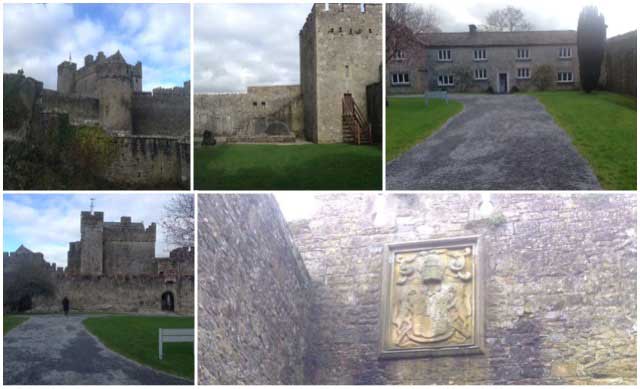Cahir Castle is a magical and enchanting Medieval Fortress that is full of surprises and is one of Ireland’s largest and best preserved Medieval Castles.
Contact Details
Cahir Castle,
Castle St,
Cahir,
Co. Tipperary.
Phone – +353 52 7441011
Fax – +353 52 7442324
E-mail cahircastle@opw.ie
Admission Fees
Family:€13
Adult: €5
Group/Senior: €4
Child/Student: €3
Cahir Castle does not have debit or credit card facilities.
Opening Hours
Mid October – February Daily 9:30 – 16:30
March – Mid June: Daily 9:30 – 17:30
Mid June – August Daily 9:30 – 18:30
September – Mid October 9:30 – 17:30
Cahir Castle is closed at Christmas from Christmas Eve the 24th to the 30th December .
The average length of a visit to Cahir Castle is an hour.
Guided Tours need to be booked in advance. Maximum number of people on each tour is 50 and takes approximately 40 minutes.
The Guide book is available in English, Irish, French, German, Italian and Spanish.
Cahir Castle has many seasonal events for more information please call the above number
Photography is allowed at Cahir Castle but if you are taking pictures for commercial use you
The Audio Visual movie “Cahir Castle and the Story of Irish Castles”. Takes 15 mins and is available in English, Irish, French, Italian and German.
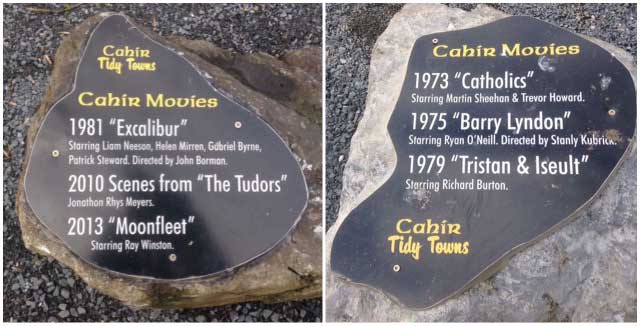
Please note Cahir Castle offers a wonderful Educational Package for schools and offers a wide range of activities for visiting schools.
Sinead’s Thoughts
If you are interested in visiting Castles in Ireland put Cahir Castle at the top of your list, it is breathtaking. Having been brought up less then an hour from Cahir Castle I am ashamed to admit this was my first time visiting this amazing place. As I approached the Castle which is situated in the stunning town of Cahir, I was overwhelmed by its size and perfection.
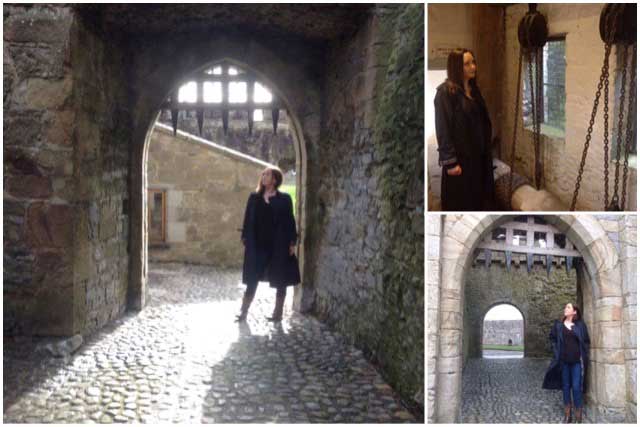
A glorious Testament to the skills of Medieval architects and builders, gleaming in the sun, surrounded by the formidable yet beautiful River Suir, it is impossible not to imagine the Norman Knights and Medieval ladies that once graced these high and intimidating Curtain Walls. Walls that loom overheard telling the story of this place with silent beauty. I can not help but think of the fear this structure must have struck into the hearts of those who gazed upon it during a time when this structure completely dominated the entire area.
Stepping inside these walls is best described as taking a step back in time. The size of this structure is intimidating yet inviting. Located on its rocky island, you can hear the flow of the water as you approach the Castle and cross the bridge, you are guided by the Castle Walls to a warm and inviting reception area where you will be greeted by wonderful and friendly staff.
Upon leaving the reception area you enter the Middle Ward with the gatehouse looming overheard. The cobblestones beneath your feet, allowing you to share in their history and secrets. You will be invited to view the audio visual film, located in the Outer Ward, in what would have been the stables, now called Cahir Cottage.
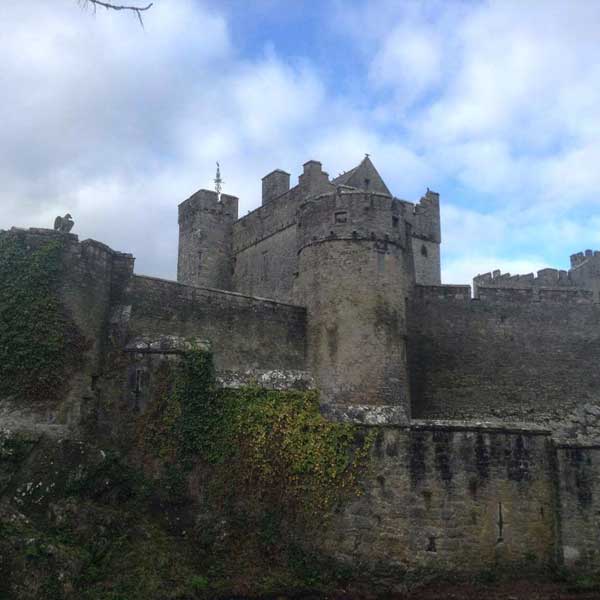
The film takes about 15 minutes and is excellent, brimming with information about Cahir and the rise of the Medieval Castle. As you explore the Outer Ward, take in the high Curtain Walls and imagine that this space would have been filled with buildings and teaming with activity. As you leave the stables the magnificent Gate House looks down drawing you in, with a cannon ball still stuck firmly in the wall, reminding me that this structure is not all romance but holds a dark past of siege and warfare.
The Middle Ages was a cruel and bloody time full of darkness and war. This Castle saw sieges and human suffering that is unimaginable. The introduction of cannons must have sounded like the wrath of God to the people living here, who during an onslaught were hearing cannon fire for the first time.
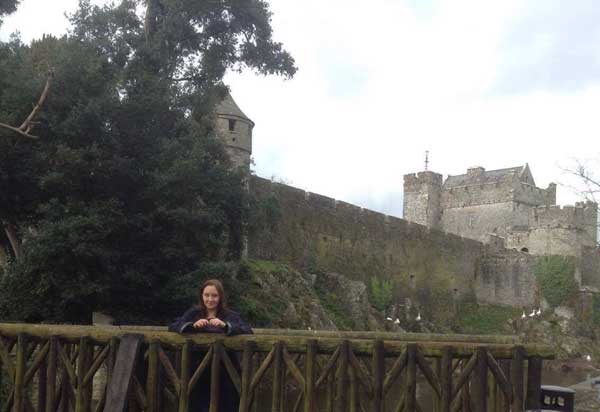
One of the very first things that caught my eye upon entering the Middle Ward of Cahir from the reception area, out of the corner of my eye I could see the magnificent Portcullis, which is still working , one of the few in Ireland today. A Portcullis that was somehow very familiar to me, I knew I’d seen it before and I had! You can imagine my delight when I was told this amazing piece of defensive engineering had appeared in the movie Braveheart.
In fact many parts of Cahir Castle were familiar as many movies were filmed here such as Excalibur and Tristan and Iseult. Possibly one of my favourite television series of all time The Tudors also filmed several scenes here and it is not hard to see why. Cahir Castle is the perfect choice to film a Medieval extravaganza, with its battlements, high towers and a sinister dungeon. Exploring Cahir Castle was a thrilling experience with so many features to take in, I was overwhelmed.
After entering the Inner Ward though the Portcullis Gate and Trap, my first stop was the reconstructed Great Hall and its apartments. The Hall is large and welcoming featuring its magnificent ceiling and your eyes will be drawn to the massive antlers that grace the wall. It is hard to believe that they once graced the head of Irish giant deer which has been extinct for 10,000 years.
The high walls of the Inner Ward make this place feel safe, the grounds graced with cannons and the Castles Well is still visible. Upon entering the Gate House I was greeted by one of my favourite features of Medieval Castles the Spiral Staircase with their own purpose in the defence of the upper floors. It’s easy to imagine the Castles fireplaces blazing with warmth and the Lords of Cahir gathered around tables, feasting and plotting. The Gatehouse is also home to an extraordinary exhibition on the lives of Medieval Woman, there is also a siege exhibition that is marvellous.
I do not say this very often but I can not wait to go back to Cahir Castle, I felt at home in this amazing structure. There is so much to see and do in Cahir and I will be back to explore it further, with its Castle, beautiful town, Cahir Abbey and the Swiss Cottage. I can’t wait to return to this enchanted place. The staff at Cahir are wonderful, friendly and their knowledge of the building is unbelievable. I am so grateful for the time and effort they took to show me the Castle and share with me the History of it’s glorious past.
Bio/History
Cahir Castle in County Tipperary, is one of Ireland’s largest and most well preserved castles, it also has an extensive and exciting history. The Castle is positioned on the natural Island situated in the majestic River Suir and is built on solid rock, offering this domineering fortress natural fortifications that Medieval castle architects and builders coveted. Cahir Castle’s full name Cahir Dhún Lascaigh meaning “The Stone Fort Of The Fortress Of The Fishery”. According to historical legend
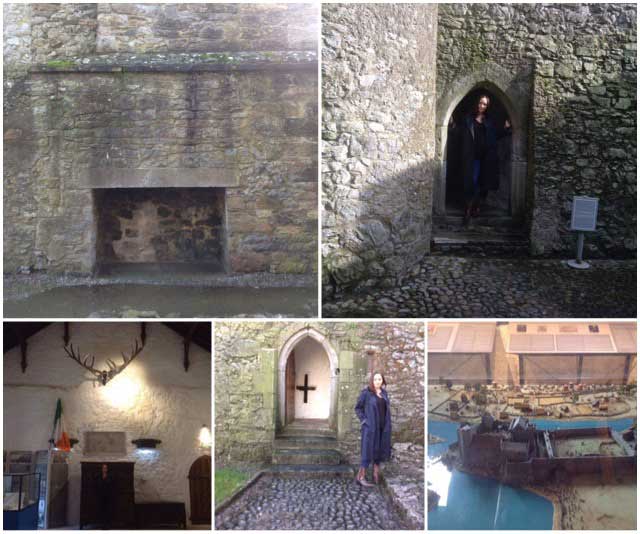
Dhún Lascaigh was the royal residence of the Kings of Munster before the arrival of Christianity in Ireland. It is said that Brian Boraimhe King of Munster refortified the structure that existed at Cahir, he would later become High King of Ireland.
His descendants the Princes of Thomond, The O’Brien’s were in position of the lands until the Norman Conquest, when in 1192 the lands were granted to Philip of Worcester by John Lord of Ireland, later King John after the death of his brother Richard The Lionheart, who died without an heir.
The first phase of the castle we see today started in the 13th century but it is unknown if these were commissioned by Philip or his Heirs.
William of Worcester’s Great Granddaughter Basilia, married Milo de Birmingham, bringing the Lordship into the Birmingham family. In 1332, Sir William de Birmingham was captured and executed by Sir Anthony Lucy. William was executed for his part in a plot, to make the Earl of Desmond King of Ireland, hence all lands and titles at Cahir reverted to the property of the crown.
In 1375 Cahir Castle was granted to the Butler Family. James Butler, Earl of Ormond was granted Cahir Castle by King Edward III, as a reward for the unwavering loyalty the family had shown to The Crown. Cahir Castle was handed down through generations of this branch of the Butler Family, starting with the death of James Butler. Upon his death James left Cahir Castle to his illegitimate son James, by Katherine who was the 3rd Earl of Desmond’s daughter, this is where this branch of the Butler Family starts and they were not considered Nobility.
This changed in 1543 when the title of Baron Caher was bestowed upon Thomas Butler by King Henry VIII. This title came with the provision that the title and lands would pass to the heirs of his body. This was unusual, as this provision meant it could pass to female heirs, in an era dominated by male issue. Most of what we see at Cahir Castle today was built by this branch of the Butler Family during the 15th and 16th centuries.
However this branch of the Butlers sided with the native Irish Catholics instead of The Crown. During the Elizabethan Wars Cahir Castle was put under siege by the Earl of Essex a favourite of Queen Elizabeth. He used cannon and a cannon ball can still be seen lodged high on the walls of the gatehouse. It is said that the capture of Cahir was the only success obtained by Essex in Ireland. Lord Caher was captured and was charged for his crimes against The Crown, Lord Caher was charged with the crime of treason but was later pardoned and continued to reside at Cahir until his death in 1627.
During the Irish Confederate Wars, Cahir Castle was put under siege twice. The Lord Caher at the time was too young to rule and was under the guardianship of George Mathew. The first surrender was to Murrough O’Brien, 6th Baron of Inchiquin in 1647 he was also known as Murrough of the burnings and again to Oliver Cromwell during his Conquest of Ireland without Cromwell firing a shot. Cromwell wrote to Mathews offering him a chance to surrender and he accepted. The letter Cromwell wrote to George Mathews, still survives today and resides in the British Museum.
The Castles main structure built by Generations of the Butlers and is multiphase with the second phase of construction taking place 200 years after its inception. There were renovations and additions made to the Castle over the centuries. In the later part of the 18th Century Cahir Castle fell into a state of disrepair. The direct line of the Butler Family came to an end with the death of Piers 10th Baron Caher, the Castle eventually found its way to the hands of Richard Butler the 12th Baron Caher. Richard built the magical Swiss Cottage in 1810. 1816 saw Lord Caher receive the additional title of Viscount Caher an Earl of Glengall. The Cahir Castle we view today can be attributed to the Earl of Glengall and William Tinsley during the 1840’s.
It was at this time Cahir Castle saw a period of renewal and restoration.
In 1964 Cahir Castle was taken into the care of the Irish State and was also declared a National Monument. There has been extensive restoration works and conservation preformed on the Castle. Cahir Castle is protected and maintained by the Irish Office of Public Works, and lovingly cared for by its dedicated staff.

